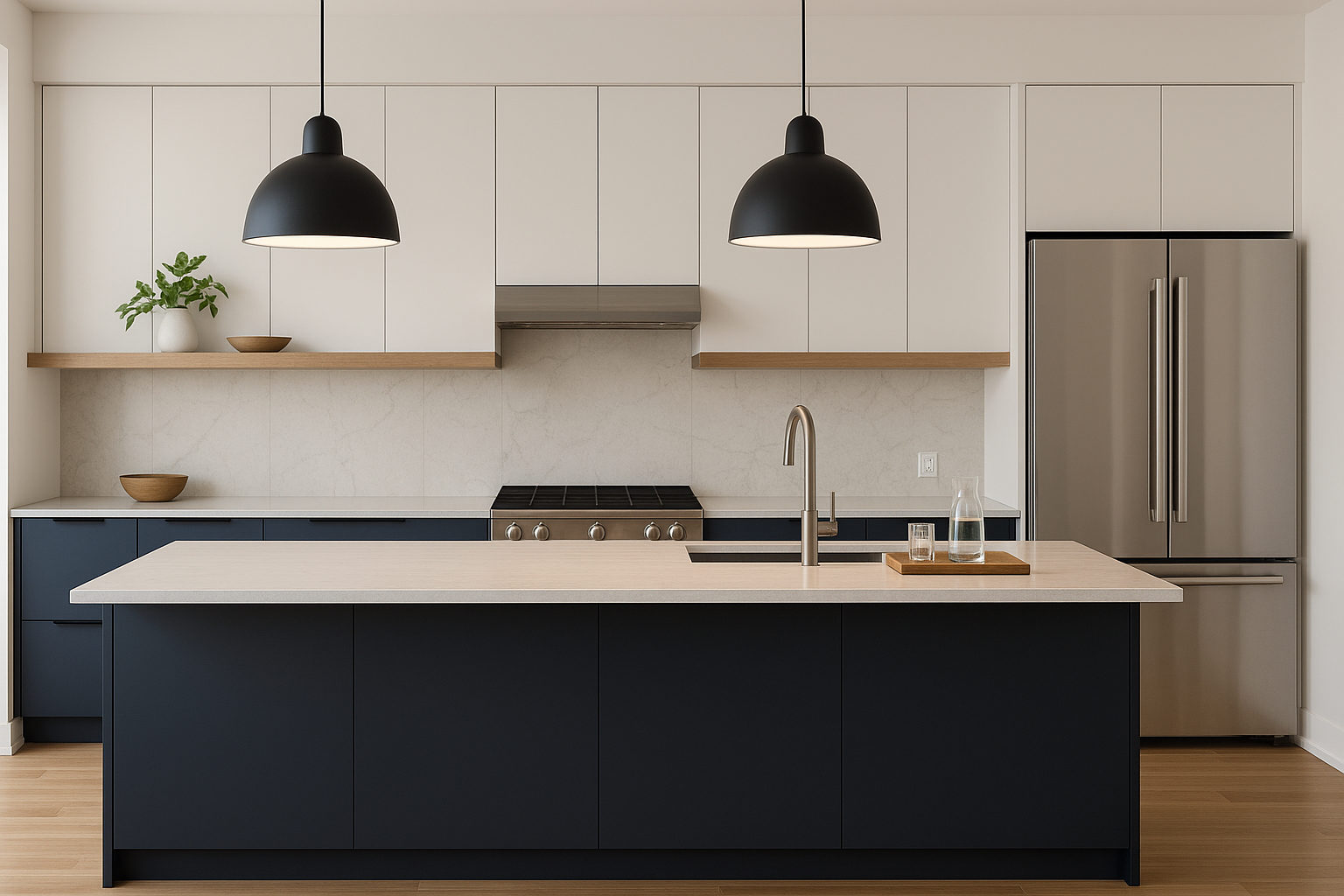This article breaks down cutting-edge design ideas, innovative storage solutions, and renovation tactics that can transform any kitchen into a space that is both beautiful and functional.
1. Modern Kitchen Design Principles
Form Meets Function
Modern kitchen design doesn’t prioritize looks at the expense of practicality. The best designs blend clean aesthetics with intuitive workflows.
Minimalism: Sleek lines, flat-front cabinetry, and clutter-free countertops.
Neutral Palettes: Whites, greys, and earthy tones dominate modern kitchens.
Mixed Materials: Combine wood, stone, steel, and glass for depth and interest.
Popular Layouts
Galley: Ideal for small homes—compact, efficient, and easy to work in.
L-Shaped: Perfect for open spaces, with plenty of counter and cabinet space.
U-Shaped: Maximum storage and surface area, great for serious cooks.
Island Layout: Central islands offer extra prep space, storage, and seating.
2. Transformative Design Ideas
Smart Islands
Incorporate built-in outlets, warming drawers, or wine fridges.
Go bold with a contrasting color or natural wood finish.
Floating islands with open shelves add airiness.
Statement Backsplashes
Full-slab marble or quartz backsplashes are replacing traditional tiles.
Backlit glass or metal panels create a futuristic vibe.
Herringbone and geometric patterns add texture.
Integrated Appliances
Hidden fridges, microwave drawers, and flush cooktops contribute to a seamless look.
Handleless cabinets and push-to-open drawers enhance the aesthetic.
Open Shelving
Combine with closed cabinets for balance.
Display dishware, plants, or cookbooks with intention.
3. Creative Storage Solutions
Smart storage is essential for a kitchen that works. Think beyond basic cabinets.
Vertical Optimization
Install floor-to-ceiling cabinets.
Use upper areas for infrequently used items.
Add hooks or rails for utensils and pots.
Pull-Outs and Inserts
Pull-out pantry towers, spice racks, and trash bins streamline access.
Use drawer organizers for cutlery, utensils, and spices.
Deep drawers with peg systems keep plates in place.
Corner Solutions
Replace dead corners with lazy Susans or corner pull-out units.
Diagonal corner drawers are another modern alternative.
Multi-Function Furniture
Benches with built-in storage for eat-in kitchens.
Rolling carts for additional workspace and mobile storage.
4. Lighting That Elevates the Space
Lighting is one of the most underestimated tools in kitchen design.
Layered Lighting
Ambient: Ceiling lights for overall brightness.
Task: Under-cabinet lights for chopping and prepping.
Accent: Pendants over islands or LED strips in toe kicks.
Modern Fixtures
Matte black, brass, or mixed-metal pendants.
Sculptural or linear LED bars for a sleek look.
5. Budget-Friendly Renovation Tips
You don’t need to gut your kitchen to give it a fresh look. Focus on high-impact, lower-cost upgrades:
Cabinet Refresh
Repaint or refinish existing cabinets.
Change the hardware to matte black or brushed brass.
Remove upper cabinets and replace with open shelving.
Countertop Swap
Replace laminate with affordable quartz or butcher block.
For a luxury feel, go with waterfall edges on islands.
Backsplash Update
Peel-and-stick tiles for renters or DIYers.
Add a full-wall backsplash for visual drama.
Flooring Options
Luxury vinyl plank (LVP) mimics wood or stone but is water-resistant and budget-friendly.
Large format tiles in neutral tones add elegance and space.
6. Kitchen Tech and Smart Upgrades
Welcome to the era of smart kitchens—designed for convenience and efficiency.
Touchless Faucets: Hygienic and efficient.
Smart Ovens: Preheat from your phone, monitor cooking remotely.
Refrigerators with Cameras: Check contents from the grocery store.
Drawer Dishwashers: Energy-efficient and space-saving.
Pro tip: Don’t overdo tech. Focus on features you’ll use every day.
7. Sustainable Choices That Matter
Make your renovation eco-conscious without sacrificing style.
Reclaimed Wood: Use for shelving, flooring, or accent walls.
Energy Star Appliances: Reduce your carbon footprint and utility bill.
LED Lighting: Long-lasting and energy-efficient.
Water-saving Faucets: Cut water use without losing pressure.
8. Color Trends and Finishes for 2025
Color Palettes
Earthy Greens & Clays: Natural tones for calming effect.
Matte Black & Graphite: Strong contrast in modern spaces.
Warm Neutrals: Taupes, soft beiges, and muted creams.
Finish Trends
Textured Wood Grain: Adds warmth and interest.
Brushed Metal Accents: Handles, faucets, and fixtures.
Matte Finishes: Clean look, less fingerprint-prone.
9. Kitchen Design Mistakes to Avoid
Avoid these pitfalls for a renovation that lasts:
Poor Lighting Plan: Don’t rely on a single overhead light.
Wasted Corners: Use every inch of storage space wisely.
Skimping on Ventilation: A good range hood is essential.
Too Trendy: Bold choices can date quickly. Use trends in accents, not fixed features.
10. Planning Your Renovation: Step-by-Step
Assess Needs: Cooking style, number of users, space limitations.
Set a Real Budget: Include contingency (10–20% buffer).
Sketch a Layout: Use online tools or consult a designer.
Choose Priorities: New appliances? Better lighting? More storage?
Hire the Right Pros: Check reviews, licenses, and references.
Plan Timeline: Expect delays; plan for meal alternatives.
Conclusion: Function First, Style Second—But Don’t Sacrifice Either
A truly modern kitchen balances design with utility. It reflects how you live, cook, and connect with others. You don’t need to knock down walls to transform the space—small, intentional upgrades can completely redefine it.
Start with how you use your kitchen. Then invest where it counts: storage, lighting, surfaces, and flow. Done right, a kitchen isn’t just a room—it’s a daily experience.
